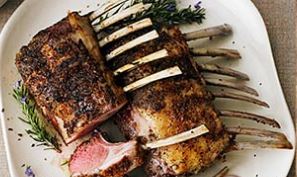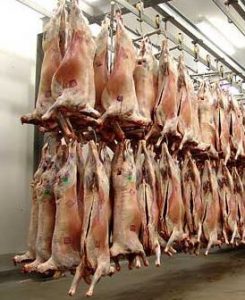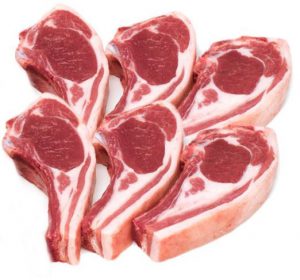Lamb – Tasty and Full of Nutritional Health Benefits
Lamb is not only tasty, but also full of Nutritional Health Benefits. Here are some Facts…
Lamb meat derives from farmed domestic sheep. Technical category of Ovine or Ovis Aries.
Another red meat type which is high in protein and richer in iron than other meats such as chicken and pork.
Lamb meat is from the young of sheep, approximately under 1 year old where. As the animal grows the meat distinction changes from Lamb to Hogget (a term used in Australia) and then onto Mutton. The way the animals are classified is determined from the number of permanent incisor teeth. You can see the classifications on the link provided from the Handbook of Australian Meat (HAM)
Lamb, being the youngest with no permanent incisors is regarded as the premium, tender and succulent tasting of the class. Lamb is most often eaten cooked without processing but with additional flavourings like salt, spices and marinades to create great taste for favourite meals. There are some nationalities that do cure and smoke lamb but generally lamb in enjoyed around the World as cooked meat. With lamb being rich in high-quality proteins, vitamins and minerals, it is an excellent product for any healthy diet.
Frequently enjoyed as a roast, lamb can be cooked in many recipes variations and enjoyed at any meal time. See some of my recipes HERE…
Sunday leg of lamb roast is always a favourite when getting the whole family together to sit down and enjoy each other’s company.
Nutritional Facts …
The main composite of lamb is protein with distinctive varying amounts of fat.
Below is a description of the main nutrient value for 100g of roast lamb.
- Water…………………….57.48 g
- Energy…………………..258 kcal
- Protein…………………..25.5 g
- Carbohydrates…………0.0 g
- Sugar………………………0.0 g
- Fibre………………………0.0 g
- Total Fat………………..16.48 g
- Saturated…………………….6.89 g
- Monounsaturated…………6.96 g
- Polyunsaturated…………..1.18 g
- Omega 3………………………0.23 g
- Omega 6………………………0.9 g
- Trans Fats……………………. ~
To see more about the Mineral and Vitamin attributes, click HERE…
Lambs Protein content…
With protein being a high component of lamb, once cooked the content will be approximately 25-27%, also containing many amino acids which are needed to help the body grow and keep it maintained. Many athletes and physically active people consume lamb as they are aware of the muscle recovery benefits that lamb, and red meat in general, has to offer. Also, after an operation or surgery it is best to get some lamb into you so it will put you on a path of quick recovery. Not necessarily doctors orders but definitely a butchers :-)).
Basically red meat will help muscle tissue re-build and repair in quick fashion.
The Fats in Lamb…
The composition of fat in lamb is saturated and monounsaturated in approximate equal levels with the amounts slightly higher than the amounts in beef and pork. Lamb also contains trans fats but unlike the trans fats found in processed foods, these trans fats are to be believed to have healthy beneficial effects for our bodies. Just like the trans fats in Waygu beef, lamb fat has the same benefits.
The most common being conjugated linoleic acid (CLA)
It has been researched the conjugated linoleic acid (CLA) has benefits that may help with cancer, coronary disease, diabetes and able to reduce body fat mass, although this is not conclusive at this point. For further details see HERE…
All herbivore animals have conjugated linoleic acid, with lamb having the highest amounts and measuring up very close to Waygu beef and well marbled beef.
Basically, the varying amounts of fats that make up the lamb meat content have many health benefits but also when cooked just right the taste is excellent. You can now enjoy that tasty fat, knowing you won’t be compromising your health.
Lamb is rich in Vitamins and Minerals…
Now that you know lamb fat can be good for you, how about the vitamins and mineral in lamb?
Here is a list that will make you happy about eating lamb
- Vitamin B12, important for blood formation and keeping your brain in check
- Selenium, important for body functioning
- Zinc, an essential mineral for growth and formation of hormones, such as insulin and testosterone
- Niacin (also known as vitamin B3), can help reduce risk of heart disease
- Phosphorus, essential for body growth and maintenance
- Iron, a rich source in lamb mostly in the form of heme-iron, more efficiently absorbed than non-heme-iron found in plants
These are just are the main vitamins and minerals but there others in lower amounts that are welcomed by the body when lamb is consumed.
Basically, consuming lamb can be compared to like taking a handful of multi vitamins and minerals except lamb tastes better.
Apart from all of these health benefits, lamb has many other attributes such as…
- High in antioxidants
- Maintenance of muscle mass, great for elderly people to keep their muscles in check
- Improve physical performance, energy builder and sustain performance longer
- Help to keep Anemia away, lambs high iron content can help with the prevention of anemia
So in Summary…
Lamb is a red meat that has many health benefits with a rich source of high quality protein, and an excellent source of vitamins and minerals, including iron, zinc, selenium and many more.
The attributes of lamb meat are able to help promote healthy muscle growth and help prolong physical performance and maintain the body through times of stress.
Not only can lamb help with keeping anaemia at bay, we are also eating lamb because of the delicious and unique flavours. Tasting a roasted prime cut of lamb will leave an enjoyable eating experience that will just keep you coming back for more every time.
If you’d like to see the technical part of Lamb Primal Cuts with explanations of what part of the carcass they come from, see my comprehensive description on my Lamb Cuts Charts page. And if you would like to see some easy to prepare recipes then click over to my Lamb Recipes page. I am sure there will be something for you to try out when you cook your next lamb meal.
I hope you have learned a bit about lamb meat today and discovered the many benefits that lamb can give each and every one of us when we enjoy a tasty lamb meal.
Feel free to share my page and leave a comment down below.
Thanks…John
What a great post, which pretty much confirmed my thoughts on lamb. It is one of my favorite meats and when cooked just right, it can literally melt in the mouth. My only concern with lamb is the cost. With lamb offering so many health benefits, its a shame that it is one of the most expensive meats to buy. For somebody who wants the health benefits of eating lamb, but can afford the price, would goat offer a suitable alternative?
Hi Daniel, thanks for stopping by my site. Yes, you’re right, lamb has become quite expensive these days. Demand and the cost of production, like all farming these days, has affected meat prices in general, but when you get the chance to have a bit of lamb make it becomes an enjoyable experience and one to savour.
Goat is just as good as lamb but a little less fatter than lamb and can be just as enjoyable. It is important to try and buy young goat meat as when goats age the meat can become gamier in taste and smell when cooking. If you like that, then that’s fine. Goat is a popular meat in India as they use the meat for their famous curries. The spices in curries help mask the gamier taste, and goat meat is much more affordable for the Indian population.
Thanks and next time you have lamb you can know you are eating healthy.
John
very interesting post. I enjoy lamb very much but have not had any variety in dishes and recipes. It’s mostly lamb curry. I always wanted to have a roast leg of lamb and tried but it came out very tough and chewy. i think that put me off lamb for a very long time, but im back to enjoying it.
Can you tell me how to roast a leg of lamb where it just melts off the bone?
Hi Mubs, and thanks for dropping by my site. Glad to hear that you enjoy the taste of lamb and try out some of these recipe on my Lamb Recipes page.
Now for a lamb leg roast where the meat pulls off the bone, here’s just a simple hint. You just need to season it the way you like, rub a little oil onto a sheet of aluminium foil, wrap it so you can open from the top to check it, and then place into your oven and roast it on a very low temperature for a long time. Something like 120 to 140 degrees C for hours. The time will depend on the size of the leg, and you can click on my Hints and Tips page and scroll down to my Temp Chart Conversion Info, and a bit further down from there you will find a brief explanation on the “Low and Slow” cooking method.
You can use this method for any roast cooking and the meat will just soften and pull apart every time.
Hope you try it out and I will be adding a great Roast Lamb recipe soon.
Cheers…John